A switching-based backstepping sliding mode control for space manipulator in presence of gravity variation①
2022-01-09LiuFucai刘福才ZhaoWennaMengLingcongLiuShuo
Liu Fucai(刘福才),Zhao Wenna,Meng Lingcong,Liu Shuo
(*Key Laboratory of Industrial Computer Control Engineering of Hebei Province,Yanshan University,Qinhuangdao 066004,P.R.China)
(**Engineering Department,University of Sheffield,Sheffield,UK)
Abstract
Key words:space manipulator,microgravity,switching system,multi-Lyapunov functions,backstepping sliding mode control(BSMC)
0 Introduction
The space manipulator is now integral to various significant missions carried out in the space for its powerful and flexible capabilities[1].Exploring favorable control methods to improve the control precision of space manipulator turns out to be quite necessary.
To ensure that a space manipulator functions well in performing space missions,conducting simulation tests on the ground is an indispensable process.The first concern is how to improve the accuracy of simulation in microgravity environment since the fact that many issues such as friction,links flexibility and hinge clearance are all related to gravity cannot be ignored.To solve these problems,traditional ways include the drop tower[2], parabolic flight[3], air flotation[4],buoyancy method[5],suspension method[6],and so on.Recent researchers have yielded a great many inspiring results.The possible application of planar airbearing microgravity simulator has been studied for the orbital capture manoeuvre and experiments results show that this simulator can be used to verify some control methods and strategies[7].A calibration system constructed to simulate the microgravity environment can be able to counterbalance the impact of gravity upon the space manipulator[8].The combination between neutral buoyancy and electromagnetic to balance the gravity and simulate the microgravity has been proved to be effective on the tested-body and its simulation precision is higher than that of neutral buoyancy mechanism[9].Microgravity simulation systems introduced above are categorized into environment simulation,which,however,can’t provide long-time and reliable microgravity environment.In view of this,the simulation of motor behavior is regarded as a favorable substitute for environment simulation[10].Therefore,a fuzzy adaptive robust control was developed for space manipulator with change of gravity from ground to space,where the fuzzy algorithm is designed to approximate the uncertainties of system,the approximation error is compensated by applying a robust control algorithm[11].However,the determination of fuzzy rules and membership functions are based on experience.Given the variation of friction characteristics in different gravity environments,an active disturbance rejection control(ADRC)was put forward,in which particle swarm optimization was introduced to optimize parameters of ADRC[12].Nevertheless,if the error in ADRC at initial time is too large,the control system may confront the conflict between quickness and overshoot.
In this study,a switching-based backstepping sliding mode control(SBSMC)is developed for space manipulator.Switching control has extensive application background for complex robotic systems[13-15]and the theory of multi-Lyapunov functions are often used in proving the stability of the switching system[16].In addition,sliding mode control is widely applied in the field of robotics for good robustness to system uncertainties while backstepping wins reputation for its characteristic to reduce design complexity of system[17-19].In the approach of SBSMC,two subsystems are constructed for the space manipulator,two different kinds of backstepping sliding mode(BSM)controllers are then designed for these two subsystems.The switching mechanism dependent on event is set to trigger the synchronous switch of the target subsystem and its corresponding controller.The strategy proposed in this paper combines the advantages of switching control and BSM control and shows high efficiency and strong robustness in trajectory tracking of the space manipulator against the change of gravity environments.The stability of the control scheme can be guaranteed by the aid of multi-Lyapunov functions.
This paper is organized as follows.Section 1 describes mathematical models for the space manipulator,and Section 2 offers the architecture of the proposed scheme.The stability of SBSMC for the space manipulator is proved in Section 3.Section 4 demonstrates the experiment results and Section 5 draws a conclusion.
1 System description
The following are assumptions made on the space manipulator system[11](as shown in Fig.1).
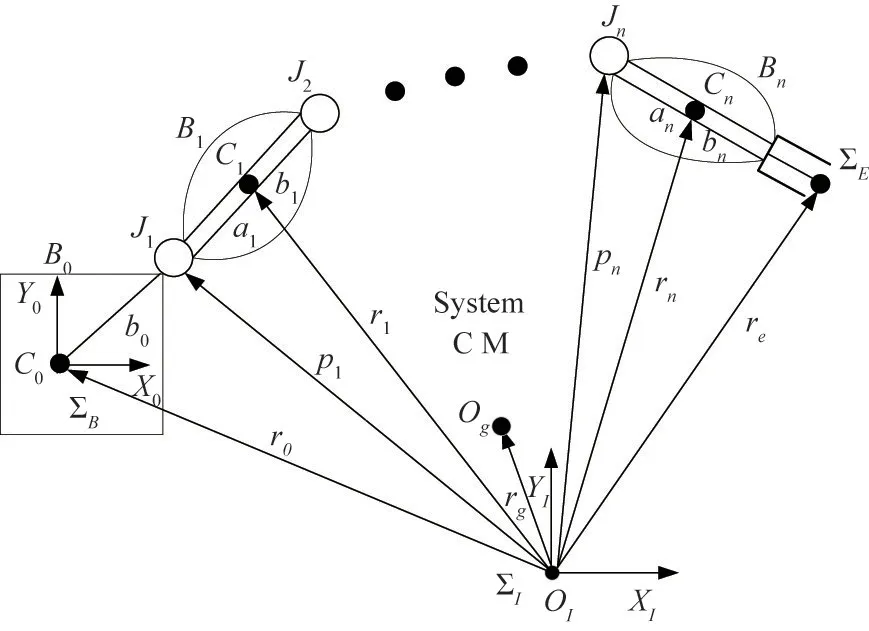
Fig.1 free-floating space manipulator with n-DOF
Assumption 1 The system is a rigid body system.
Assumption 2 The system is composed of one base andnlinks.The pose of the base isn’t activecontrolled.Each joint of the link has one rotational degree of freedom(DOF)and is active-controlled.
1.1 Ground subsystem



1.2 Space subsystem
During the operation in the space,the motion of system increases 6-DOF as a result of a free-floating base.The Lagrange function is equal to the kinetic energy.Taking account of the influence of friction,the dynamic equation of the space subsystem derived from Lagrange equation is expressed as



The following is one of characteristics of kinetic equation for the space manipulator[20].
Property 1M(q),which is bounded,is a positive definite symmetric matrix,i.e.,

where positive constantsλmandλMare the minimum and maximum eigenvalues ofM(q),respectively.
2 Design of SBSMC
Since the space manipulator involves two subsystems,namely,ground subsystem and space subsystem,two kinds of BSM controllers are required for these two subsystems.Originally,the debugging of space manipulator is carried out on the ground,thus the ground subsystem and its corresponding controller takes effect.As soon as the measuring instrument of gravity acceleration[21](which is installed in the spacecraft to exercise real-time monitoring of the gravity acceleration)detects that the gravity acceleration≤10-4g(g refers to acceleration of free fall),the control system switches from the ground subsystem to the space subsystem quickly,at the same time,the ground controller is replaced by the space one.
An adaptive law is adopted to estimate the disturbanceωiofith(i=1,2)subsystem,and

Therefore,Eqs(1)and(3)can be written as

Assuming that the inverse ofqexists and from Property 1,Eq.(8)can be obtained.

For the space manipulator subsystems described in Eq.(7),the main steps of BSM controllers are presented as follows.
Step 1 Define Lyapunov functionV i1

whereε1is the position error and is defined by

whereq dis the desired joint position,and

The virtual controlα1is taken as

wherec∈Rn×nis a positive definite symmetric constant matrix.
Construct the following equation

Using Eqs(13)and(14),the derivative ofV i1becomes


Step 2 Another Lyapunov functionV i2is defined as

wheresis the sliding variable,which is set as

whereλ1∈Rn×nis a positive definite symmetric constant matrix.
The derivative of Eq.(14)holds the following equation

Based on Eqs(14),(15)and(18),the derivative ofV i2is given by

Substituting Eq.(8)into Eq.(19),yields

Step 3 For each space manipulator subsystem,Lyapunov function is chosen as



According to Eqs(20),(22)and(23),the derivative ofV ican be obtained as follows.
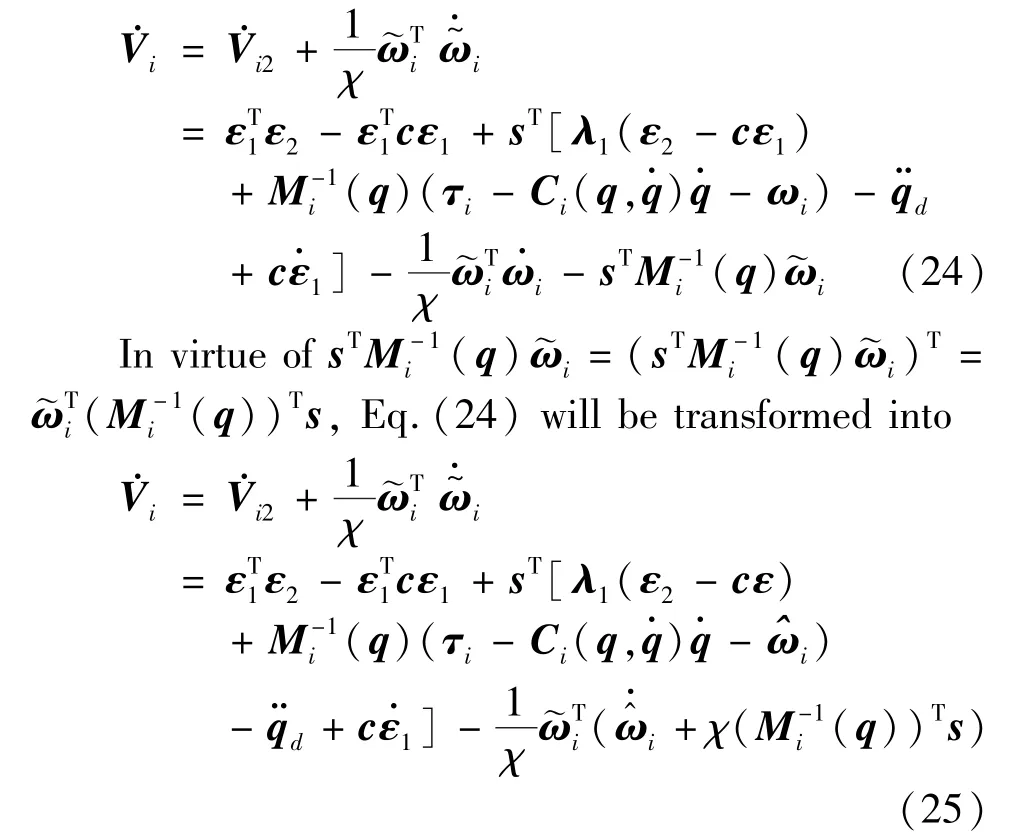
The adaptive law of disturbance is depicted by

Hence,Eq.(25)can be described as


The following is the control law formulated for each subsystem:

where,τieqis the equivalent control law whileτisstands for the sliding mode control rule,they are computed by

where,ρis a positive constant,h∈Rn×nis a positive definite diagonal coefficient matrix and tanh(·)is a hyperbolic tangent function,which satisfies

The control scheme projected in this article for space manipulator is shown in Fig.2.Fig.3 reveals the structure of BSM controller designed for the space manipulator subsystem.

Fig.2 Architecture diagram of SBSMCfor space manipulator

Fig.3 Architecture diagram of BSM controller for space manipulator subsystem
3 Stability analysis
According to the theory of multi-Lyapunov function,the first thing is to make sure the stability ofith subsystem.
By substituting Eqs(29)and(30)into Eq.(27),yields

Let

accordingly,

Denoteε=[ε1ε2]T,one can get

Then,Eq.(32)can be rewritten as


The next step is to discuss the stability of the switching system.Assume that there areai,biandci(all of them are constants)in each subsystem.
By using Eqs(9),(16)in Eq.(21),it is easy to know that

then

Based on Eq.(36),the following inequality can be derived

According to Eq.(38)and Eq.(39),the following inequality holds

that is

Letσ(t)=i,∀t∈[t0,t0+τ],whereσ(t)remarks the switching signal andτis a positive constant,then


According to Eqs(37),(42)and the above assumption,the following inequality can be obtained:

Further

It can be deduced from Eq.(44)thatV1(t2)≤V1(t0)so long asτis large enough.On the basis of stability theory of multi-Lyapunov functions,the nonlinear switching scheme applied in this paper is stable globally and asymptotically.
4 Simulations
For the purpose of checking the capabilities of SBSMCfor space manipulator under gravity-varying conditions,a set of simulations are conducted with Matlab.For more intuitive comparison,simulation results of PD control for space manipulator are also exhibited.The parameters of space manipulator are shown in Table 1.The parameters of PD controller are set to be

and the desired trajectory for space manipulator is given as


Table 1 Parameters of 2-DOF space manipulator
4.1 PD control for space manipulator
Fig.4 and Fig.5 show the tracking performance of the space manipulator with gravity-compensated PD controller in both cases.The PD controller is formed as

Based on Fig.4,it is obvious that by employing PD controller with gravity compensation,the space manipulator performs a good behavior of trajectory tracking both in end-effector and two joints.However,this kind of PD controller is not appropriate for the manipulator in the space,as it is shown in Fig.5,which reflects the limitation of using the same PD controller in the microgravity environment.
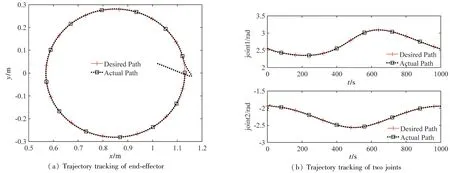
Fig.4 Simulation results in gravity environment
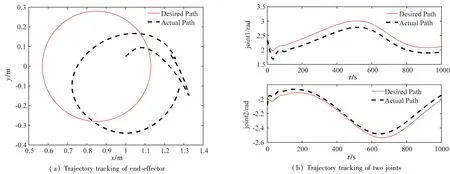
Fig.5 Simulation results in microgravity environment
Fig.6 and Fig.7 depict the results of trajectory tracking for the space manipulator by applying the PD controller without gravity compensation under two conditions.The PD controller is described as

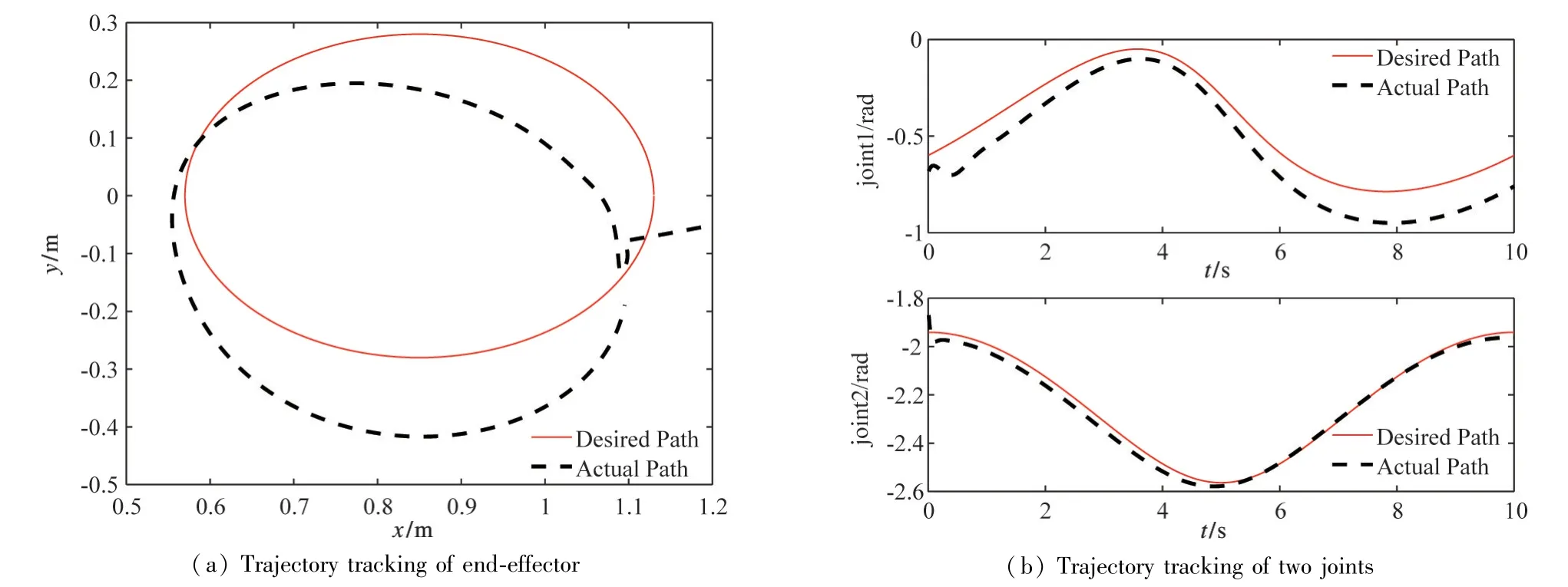
Fig.6 Simulation results in gravity environment
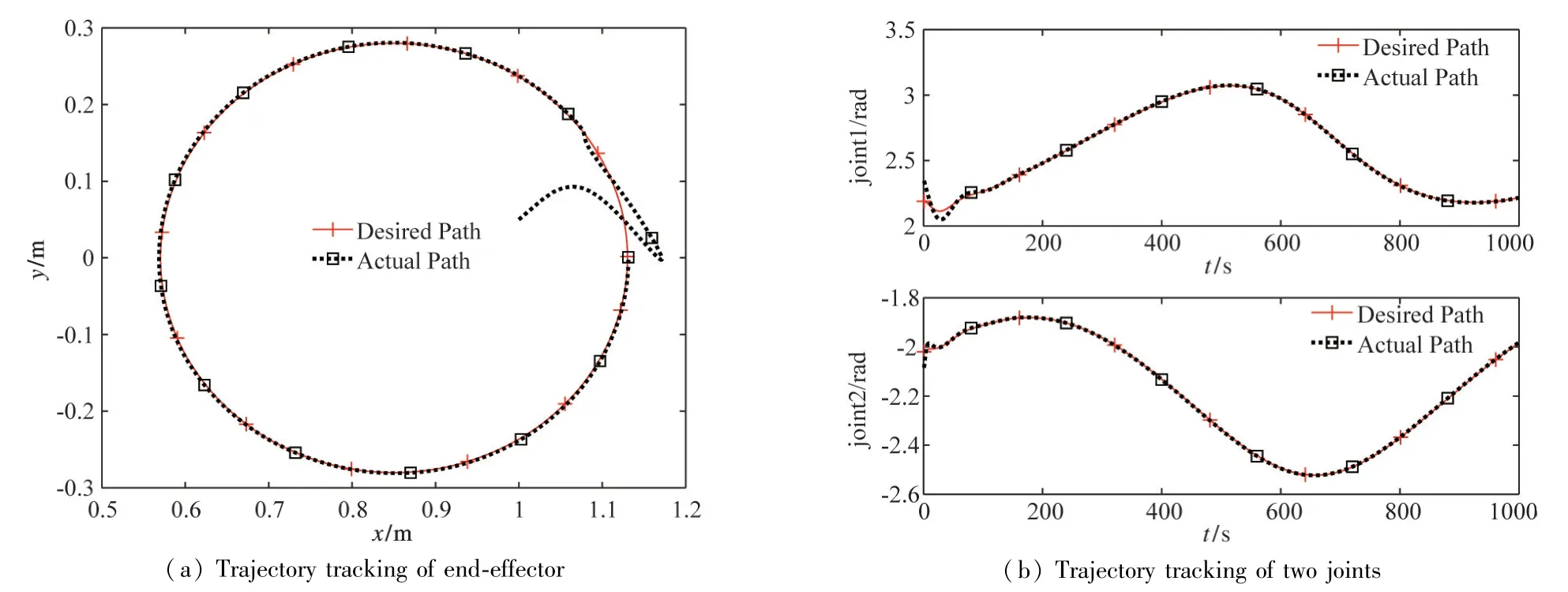
Fig.7 Simulation results in microgravity environment
As it can be noticed in Fig.7 that PD controller without gravity compensation is perfectly adequate for the trajectory tracking of space manipulator in the space.Nevertheless,the results provided in Fig.6 indicate that this controller cannot meet the control requirements for space manipulator on the ground.
4.2 SBSMC for space manipulator
At the beginning of this simulation,the ground subsystem and its BSM controller are activated.Assuming that the measuring system of gravitational acceleration detects the acceleration≤10-4g at 10,then the control system switches to the space subsystem automatically,meanwhile,the space controller substitutes for the ground one.The simulation results are presented in Fig.8.
As it can be noted in Fig.8(a)and Fig.8(b),the SBSMC approach guarantees the continuity of trajectory following in end-effector and two joints of the space manipulator despite changes in the control environments,which verifies that SBSMC is more effective and more robust than PD control in subsection 4.1 for space manipulator confronted with gravity variation.It can be noticed that the joint angles vary largely at 10 in Fig.8(b),this is because,when the system is in the free-floating state,the movement of the entire system increases 6-DOF,which makes the posture of the joint angles of the space manipulator different from that on the ground.The torques exerted on two joints are also presented in Fig.8(c)to show the stability and continuity of controlling on the space manipulator in two phases.Furthermore,it can be observed from the curves of torques that the disturbance resulting from the switching between two subsystems disappears quickly as a result of the switch of their corresponding controllers.The reason why the torques vary largely at 10 is that there is no gravity term in the control law for the manipulator system in the space compared with the situation that the space manipulator is on the ground.Fig.8(d)shows that in both periods,the tracking error maintains close to zero and the switching has no considerable effects on the tracking error of the space manipulator,except from transient vibration occuring at 10.
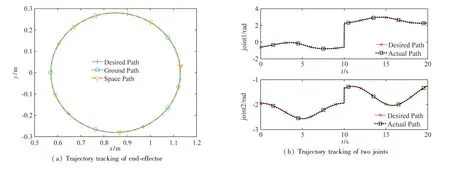
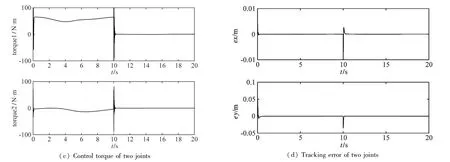
Fig.8 Simulation results of SBSMC
5 Conclusion
The main contribution of this paper is that a SBSMC methodology is developed for space manipulator to handle the trajectory tracking issue derived from the transformation of gravity environments.This research combines the merits of switching control,backstepping control and sliding mode control.Different kinds of BSM controllers are designed for two subsystems while switching mechanism is formulated to accomplish the switching between two subsystems as well as their corresponding controllers. Compared with the control strategy that the same PD controller is applied to the space manipulator at two stages,the control strategy described in this paper provides great flexibility for the space manipulator under varying gravity conditions and achieves better tracking performance.It is worth considering,however,that the behaviors of space manipulator are constrained by many factors,such as links flexibility and hinge clearance,which will be the directions of future work.
杂志排行
High Technology Letters的其它文章
- A neural network-based commutation optimization strategy and drive system design for brushless DC motor①
- Protective effect of compressing arc extinguishing lightning protection device on superimposed lightning strikes①
- Wedge template optimization and parallelization of depth map in intra-frame prediction algorithms①
- CCD signal acquisition and optimal digital denoise technology①
- Study on spiral winding swimming motion control of a slender legless creature model①
- Dynamic control for the feed system of a robotic drilling end-effector①
